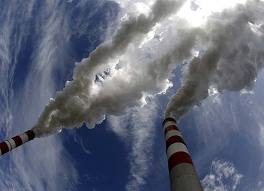Have you heard of carbon trading? Where a country or region sets a cap for its emissions, and then uses permit trading to seek out the cheapest cuts. I’m guessing you have.
But what about the carbon in trade? The carbon that moves around the world in the form of fossil fuels and finished products. Heard of it?
When we talk about carbon emissions we invariably talk about where emissions occur due to fossil fuel combustion. But carbon moves around a lot. Oil moves from the Middle East to Europe before being used and products purchased in the US are often made in China. These movements have important implications for climate policy.
This post is the first of a three part series called The Carbon Trade, which hopes to explain the basics of carbon embodied in international trade. Using data from a recent paper ‘Climate policy and dependence on traded carbon‘ we will look at how carbon is traded between where fuels are extracted, emissions are produced and products are consumed.
The Rise and Rise of Traded Carbon
In the last two decades the world has globalized dramatically. International trade has grown at roughly twice the rate of gross domestic product. As a result the global economy is more intertwined than ever. The same is true of the carbon.
A country’s carbon emissions are generally counted by the emissions that occur within its border. These are the figures used for national targets. But we can also count where carbon is extracted in the form of fossil fuels and where it is consumed in the form of finished products. And from these three different account points we can understand its trade.
The trade of carbon has grown sharply in recent years.

The combined international trade in carbon increased from 12.3 Gt CO2 in 1997 to 17.6 Gt CO2 in 2007.
In 2007 there was 10.8 Gt CO2 traded in the form of fossil fuels. This is fuels that were extracted in one country to be combusted in another.
A further 6.9 Gt were traded in the form of emissions embodied in finished products. These are emissions from making something in one country that is consumed in another.
Not only is traded carbon growing in nominal terms, but it is also growing as a share of total emissions.
The Globalization of Carbon
As global trade grows so does the share of traded carbon.

In 1997 the sum of carbon traded in fuels and products was equivalent to 55% of total carbon emissions from fossil fuels. By 2007 this figure had risen to 60%, having been slightly higher in 2004.
This growth in the traded share of emissions reflects the fact that trade in carbon embodied in both fuels and products is growing faster than total emissions.
Product Emissions on the Rise
The sharp growth in traded carbon is being driven both by fuel and product emissions, but the later is growing faster.

Between 1997 and 2007 the global economy grew at a rate of 2.5% per year, while carbon emissions grew a little faster at 2.8% per year.
Total traded carbon grew significantly faster at 3.7% per year. When separated out we can see the sharp growth of the carbon embodied in traded products, which grew at 4.6% per year, compared to the growth of traded fuels at 3.1% year.
The fact that traded carbon is growing so quickly has implications for climate policies.
The Growing Importance of Carbon in Trade
Traded carbon has grown sharply in recent years, makes up an increasing share of total emissions and its growth is being driven by a sharp rise in emissions embodied in traded products. Each of these facts has implications for national climate policies.
Robbie Andrew, one of the paper’s authors, puts it this way:
With globalisation of production, and increased international trade, we’re also seeing more fossil carbon being traded to feed that production and more emissions embodied in that international trade. One outcome of this is that carbon from elsewhere is needed to support domestic production and consumption, and any regulation of that carbon will have a domestic effect. Furthermore, some countries are benefiting more and more from emissions occurring elsewhere (whether upstream or downstream) without assuming responsibility for those emissions.
In this first post of our three part series The Carbon Trade we have focused on the growth of traded carbon in recent years. Join us tomorrow when we look at who the big five of the carbon trade are.
All the data used in this series is based on the recent, and freely downloadable, paper ‘Climate policy and dependence on traded carbon‘ by Robbie Andrew, Steven Davis and Glen Peters. Many thanks to Robbie in particular for providing the data.
This article was originally published on Shrink That Footprint. Reproduced with permission










